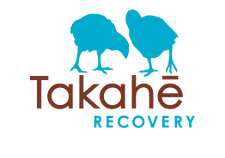
Takahē Recovery Team
We have a dedicated Takahē Recovery Team of ten staff. They’re continually researching and finding new conservation methods to ensure this taonga (treasured) bird is not lost forever.
Our operational staff are based in Te Anau. They're responsible for manging takahē across our sanctuary and recovery (wild) sites. They also look after the Burwood Takahē Centre.
Our leadership and technical support staff are based in Invercargill. These staff also work with Kākāpō Recovery.
We are advised by the Takahē Recovery Group which is a group of independent experts in various fields of conservation. The group includes members of:
- Takahē Recovery Team
- Te Rūnanga o Ngāi Tahu
- University of Otago
- Manaaki Whenua Landcare Research.
View the Takehē Recovery Annual Report 2023 (PDF, 3,798)
View the Takehē Recovery Management Plan 2021-2025 (PDF, 1,705K)
Tangata whenua and takahē

The Māori tribe (iwi) of New Zealand's South Island, Ngāi Tahu, has strong cultural and traditional associations with the takahē.
The takahē is a taonga (treasure) of Ngāi Tahu.
The Ngāi Tahu Claims Settlement Act 1998 enshrined into law the special cultural, spiritual, and traditional importance of takahē to Ngāi Tahu. In recognition of this special relationship, Ngāi Tahu is the primary partner of DOC in the Takahē Recovery Programme.
We work with Te Rūnanga o Ngāi Tahu to set the recovery plan direction and share in the decision making for the implementation of the Takahē Recovery strategy.
When takahē are transferred to a new site they do so with the blessing of Ngāi Tahu who transfer kaitiakitanga (guardianship) of the takahē to the iwi of the new site.
Fulton Hogan

The Takahē Recovery Programme has been privileged to have had incredible financial support from several partners. This has enabled continuity and quality of infrastructure, resources, and research, and also an ability to plan up to five years ahead. This has been a key pillar in enabling the success of the recovery programme – keeping us at the forefront of innovation and problem-solving initiatives.
Since 2016 our commercial partner has been New Zealand-owned civil construction company, Fulton Hogan. Operating now for 90 years, Fulton Hogan understands more than most the power and importance of enduring partnerships. Among more than 5,000 staff in New Zealand are many who love the outdoors and are committed to preserving our natural environment, and we’ve been delighted to have a number of them directly involved in takahē release and maintenance operations. And, with so many engineering and design specialists in their ranks, who better to help us develop technical solutions for the challenges our rangers face when managing recovery operations out in the field? With skilled and passionate people championing takahē recovery, Fulton Hogan is a deeply valued partner for Takahē Recovery Programme.
We thank them for their ongoing support and commitment.
Supporters
New Zealand Nature Fund

New Zealand Nature Fund support us by providing a platform for donations and expertise in fund management. With a long history with the Takahē Recovery Programme they have been supporters for over 20 years.
They support us by providing expertise in funds management and independent assurance of the investment.
Specialist veterinary advice, care, and support
Wildlife hospitals play an important role in supporting Takahē Recovery. They provide services such as hospital care, diagnosis, animal health monitoring and research. We're lucky to have four hospitals across New Zealand. This means all takahē populations have veterinary support nearby.
Dunedin Wildlife Hospital
The Wildlife Hospital is the go-to facility when we need care for birds is this area. Burwood Takahē Centre, Murchison Mountains, and Upper Whakatipu takahē sites are under three hours' drive away and Orokonui is nearby too.
Wildbase Recovery - Massey University
Wildbase and Massey University Veterinary School have a long history with conservation of New Zealand species, including takahē. They provide care and rehabilitation for takahē from across New Zealand. Pathologists supply us with a cause of death when required, and are involved in continuous research.
New Zealand Centre for Conservation Medicine (NZCCM) - Auckland Zoo
NZCCM is based at Auckland Zoo. The staff at the NZCCM play a big part in takahē conservation, especially takahē in the Auckland region. Their support includes veterinary care, research, and health screening, along with husbandry care of their resident takahē pair.
New Zealand Centre for Conservation Medicine (NZCCM)
'The Nest' Te Kōhanga - Wellington Zoo
‘The Nest’ Te Kōhanga is an award-winning wildlife hospital based at Wellington Zoo. The takahē at Zealandia are regular visitors to the facility.
